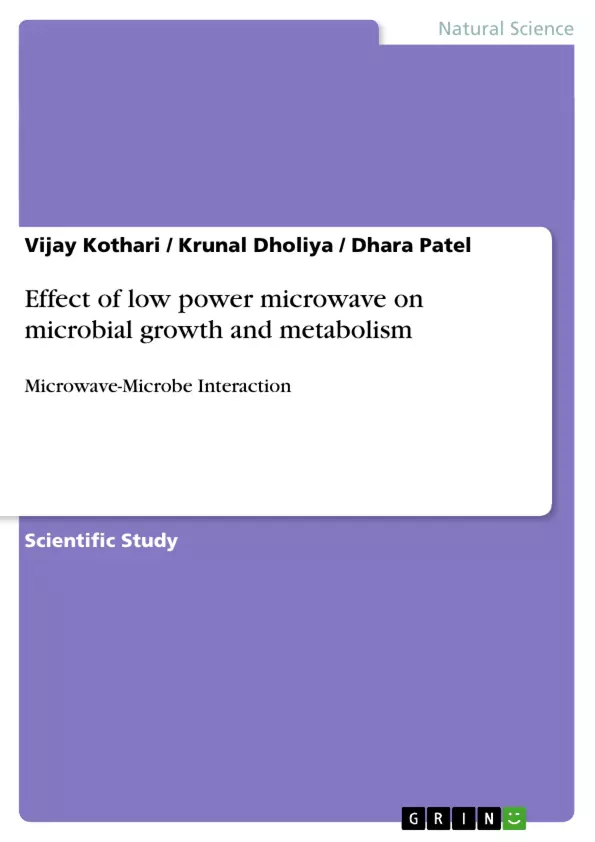This study aimed at investigating the effect of low power (90 W) microwave radiation (2450 MHz) on microbial growth, enzyme activity (protease and urease), and aflatoxin production. Thermal effect was avoided by keeping inoculum in ice while treating with microwave (for varying duration i.e. 2, 4, and 6 min). After 6 min MW treatment to S. aureus, its growth was stimulated over control by ~10%. Total protease activity in Aeromonas hydrophila witnessed a 33% decrease as compared to control after a microwave exposure of 2 min. Similar decrease of 24% in total protease activity of Candida albicans was observed after microwave exposure of 6 min. Staphylococcus aureus lost its urease activity completely after microwave treatment. Aflatoxin production was completely inhibited in Aspergillus parasiticus after microwave exposure of 2, 4, and 6 min. However, it required a 6 min microwave exposure for complete inhibition of aflatoxin production in Aspergillus flavus. Our results positively suggest existence of microwave specific non-thermal effect on microbial growth and metabolism.
Inhaltsverzeichnis (Table of Contents)
- Prologue
- Preamble
- Biological application of MW
- The Importance of the Study
- Statement of the Problem
- Rationale of the Research Work
- Aim and Objectives
- Literature Review
- Interactions of Microwave with Biological Materials
- Thermal Mechanisms of Interaction
- Athermal (Non-thermal) Mechanisms of Interaction
- Mode of action: Molecular mechanisms
- Interaction at sublethal dose
- Difference between MW heat and conventional heat
- Enzyme activity
- Aflatoxin
- Interactions of Microwave with Biological Materials
- Materials and Methods
- Test organisms
- Culture maintenance
- Culture activation
- Inoculum preparation
- MW oven and its maintenance
- MW treatment
- Experimental outline
- Growth measurement
- Protease estimation
- Urease estimation
- Aflatoxin estimation
- Statistical analysis
- Results and discussion
- Effect on growth
- Effect on growth and protease activity
- Gram positive
- Gram Negative
- Yeast
- Effect on growth and urease activity
- Effect on growth and aflatoxin production
- Epilogue
Zielsetzung und Themenschwerpunkte (Objectives and Key Themes)
This research investigates the effects of low-power microwave (MW) radiation on microbial growth, enzyme activity, and aflatoxin production. The study aims to determine the impact of MW exposure on various microorganisms and their associated enzymatic functions.
- The influence of MW radiation on microbial growth.
- The effects of MW on enzyme activity, specifically protease and urease.
- The impact of MW on aflatoxin production by microorganisms.
- The potential for MW technology as a tool for controlling microbial growth and enzyme activity.
- The differences in response to MW between different microbial groups (Gram-positive, Gram-negative, and yeasts).
Zusammenfassung der Kapitel (Chapter Summaries)
The prologue introduces the research topic, outlining the background of microwave (MW) technology and its potential applications in biology. It emphasizes the significance of the study and defines the research problem. The aim and objectives of the research are clearly stated.
The literature review provides a comprehensive overview of existing knowledge on the interactions of microwaves with biological materials. It explores both thermal and non-thermal mechanisms of interaction, highlighting the mode of action and molecular mechanisms involved. The review also delves into the effects of MW exposure at sublethal doses and compares MW heat to conventional heat. Enzyme activity and aflatoxin production are discussed in the context of MW exposure.
The materials and methods chapter details the experimental design, including the test organisms used, culture maintenance and activation procedures, MW treatment protocols, and analytical techniques for growth measurement, enzyme estimation, and aflatoxin analysis. The statistical methods employed for data analysis are also described.
The results and discussion section presents the findings of the study. The impact of MW radiation on the growth of various microorganisms is examined, including the effects on enzyme activity (protease and urease) and aflatoxin production. The chapter analyzes the data and interprets the results in light of previous research, exploring the potential mechanisms underlying the observed effects.
Schlüsselwörter (Keywords)
This research focuses on the effects of low-power microwave radiation on microbial growth, enzyme activity, and aflatoxin production. Key terms and concepts include microwaves (MW), microorganisms, enzyme activity (protease, urease), aflatoxin production, thermal and non-thermal mechanisms, sublethal doses, and statistical analysis.
- Quote paper
- Vijay Kothari (Author), Krunal Dholiya (Author), Dhara Patel (Author), 2012, Effect of low power microwave on microbial growth and metabolism, Munich, GRIN Verlag, https://www.grin.com/document/201075



